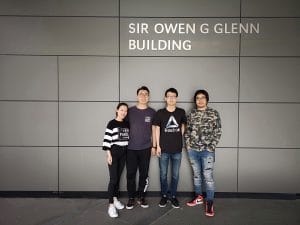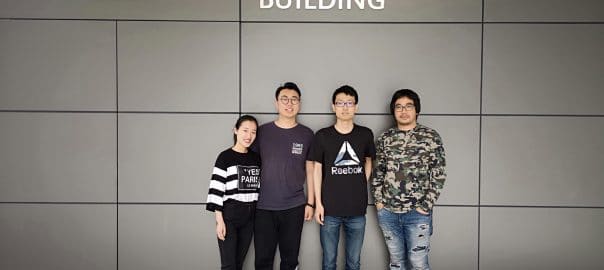We have interviewed the 2018 MikesBikes World Champs winner, Whatever-Go with Wiput Tantulaphongse, Yijing Tang, Meiyicong Lin, Zhen Peng and Fengkai Han from University of Auckland. They have also managed to achieve the second highest Shareholder Value from the past 9 MikesBikes World Champs!

In this interview they talk about their experience in the simulation, their decision-making process, strategy and advice to future students.
Smartsims: What is your decision making process within the simulation and in the competition?
Whatever-Go: First of all, we look at the information in the Scenario Tab then we discuss about the strategy of the investment. The decision was based on the forecast market volume and the expected market share of our team. The expected market share is derived from the advertising expenditure and the target price. Moreover, we calculated the capacity needed to produce the expected amount of bikes two years in the future. The last decision made on the financial aspect. We simulated cash flow analysis and expected equity in the next rollover, so, we had the rough idea of how our cash on hand would be, and the likelihood of achieving that target. All of the decision made was influenced by the forecast of competitors’ decision as well.
Smartsims: What was your strategy going into the simulation?
Whatever-Go: Our strategy is to be the market leaders who produced high quality products with reasonable price. This strategy needs a thorough analysis of every aspect including marketing, product development, financing, and production as a whole. We had to understand the risk of each decision made in the particular rollover. We invested heavily in product development and advertisement in the first three rollovers because we expected to secure the highest market share earlier than our competitors. The forecast of the cash balance was really important to understand the sensitivity of financial information.
For example, if the expected market share change by 1%, we need to know how this would affect the ending cash balance. So, we can prepare the financing strategy whether we should take debt or equity financing. In the middle of the competition, we focused on optimizing the operation activities and maintaining a reasonable market share regardless of the price of products. We estimated the contribution margin of each product to ensure that every single product lines made the profit the team.
Every rollover, we aim for the highest profit which is the ultimate goal of a business. Moreover, we also focused on giving the dividend to shareholders. For the last two rollovers, we invested in investor PR to help our SHV and tried to maintain the investor PR index at 1 which is the optimal point.
Smartsims: What challenges did you face? How did you overcome these?
Whatever-Go: The most challenging part is the first three rollovers.
First rollover: We were not sure what the price of the Adventurer bike would be. If we set the price too high, it would lead to having a low profit in the following rollover. If we set the price too low, we could end up with loss sales which means loss of profits. In addition, we had to come up with the strategy for our product development. We had to guess which market to place the bike into. Finally, we decided to develop Adventurer and Kids bikes. We made the decision based on the profitability of Adventurer in the long run because we can double the profit of the Adventurer segment by investing 2-3 million. For kids segment, we had the assumption that most of the competitors would develop Racers. We decided to take a risk in developing a product in the Kids segment. The assumption in that moment was to take 30%-50% of kids market and gain a huge amount of profit rather competing in the “red ocean market” of Racers segment.
Second and Third rollovers: It was challenge to guess the competitors’ strategy. We had to estimate and monitor changes in price, awareness, PR, and quality of our competitors’ product. This helped us to understand the trend of each competitors and we adjusted our plan accordingly.
For both situations, teamwork is the answer to overcome all of these challenging issues. The more we share to the team, the more solutions we came up with.
Smartsims: Was there anything, in particular, you did that you think helped to prepare yourself?
Whatever-Go: Cash flow analysis, cash balance sensitivity analysis, product development plan (for the whole simulation period), and the most important part is to understand how advertising, operations, finance and product development are linked together, and how the simulation software works. Read the Players Manual!!!
Smartsims: What do you think of the business simulation?
Whatever-Go: The simulation needs comprehensive decision making method.
This is one of the best activities we have done so far throughout the course.
MikesBikes shows every single element in the accounting perspective such as balance sheet, cash flow statements, statement of change in equity, and the costing information for management accounting. This is the good experience for management students so far.
Smartsims: Comments on your experience in your course simulation and with the MikesBikes World Champs
Whatever-Go: We had fun in the course and found that in MikesBikes World Champs is far more challenging because of the additional rules such as the limitation of numbers of development in a roll.
Smartsims: Advice to future students
Whatever-Go: Focus on your business strategy, set the target, think about the plan to achieve the target, adjust your decisions based on the business environment, focus on every aspect equally (advertising, operations, finance, R&D) because each decision supports each other and contribute to your overall Shareholder Value.
